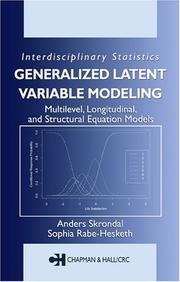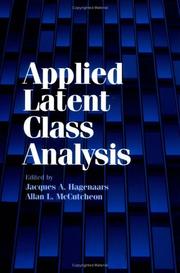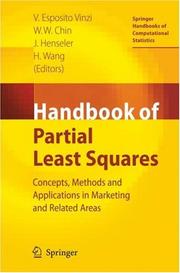| Listing 1 - 10 of 15 | << page >> |
Sort by
|
Book
ISBN: 3847013815 373701387X 384711381X Year: 2022 Publisher: Göttingen : V&R Unipress,
Abstract | Keywords | Export | Availability | Bookmark
 Loading...
Loading...Choose an application
- Reference Manager
- EndNote
- RefWorks (Direct export to RefWorks)

ISBN: 1584880007 Year: 2004 Publisher: Boca Raton, Fla Chapman & Hall/CRC
Abstract | Keywords | Export | Availability | Bookmark
 Loading...
Loading...Choose an application
- Reference Manager
- EndNote
- RefWorks (Direct export to RefWorks)
Mathematical statistics --- 519.2 --- Probability. Mathematical statistics --- Latent structure analysis. --- Latent variables. --- 519.2 Probability. Mathematical statistics --- Latent structure analysis --- Latent variables --- Constructs, Hypothetical --- Hypothetical constructs --- Variables, Latent --- Multivariate analysis --- Variables (Mathematics) --- Correlation (Statistics) --- Analyse des données
Book
ISBN: 9811967032 9811967024 Year: 2022 Publisher: Gateway East, Singapore : Springer,
Abstract | Keywords | Export | Availability | Bookmark
 Loading...
Loading...Choose an application
- Reference Manager
- EndNote
- RefWorks (Direct export to RefWorks)

ISBN: 1107127556 1280417269 9786610417261 1139145630 0511180675 0511065949 0511059639 0511326408 0511499531 0511068077 9780511065941 9780511068072 9780511059636 9780511499531 9781280417269 0521594510 9780521594516 9780521104050 052110405X 0521594510 9780521594516 9781107127555 6610417261 9781139145633 9780511180675 9780511326400 Year: 2002 Publisher: Cambridge Cambridge University Press
Abstract | Keywords | Export | Availability | Bookmark
 Loading...
Loading...Choose an application
- Reference Manager
- EndNote
- RefWorks (Direct export to RefWorks)
Applied Latent Class Analysis introduces several innovations in latent class analysis to a wider audience of researchers. Many of the world's leading innovators in the field of latent class analysis contributed essays to this volume, each presenting a key innovation to the basic latent class model and illustrating how it can prove useful in situations typically encountered in actual research.
Latent structure analysis. --- Latent variables. --- Constructs, Hypothetical --- Hypothetical constructs --- Variables, Latent --- Latent structure analysis --- Multivariate analysis --- Variables (Mathematics) --- Correlation (Statistics) --- Latent variables --- #SBIB:022.AANKOOP --- #SBIB:303H520 --- Methoden sociale wetenschappen: techniek van de analyse, algemeen --- Academic collection --- Quantitative methods in social research --- Mathematical statistics --- Social Sciences --- Sociology
Book
ISBN: 9781597181082 9781597181037 1597181080 159718103X 1597181048 9781597181044 Year: 2012 Publisher: College Station (Tex.) : Stata Press Publication,
Abstract | Keywords | Export | Availability | Bookmark
 Loading...
Loading...Choose an application
- Reference Manager
- EndNote
- RefWorks (Direct export to RefWorks)
This book is devoted to generalized linear mixed models for binary, categorical, count, and survival outcomes. This volume has seven chapters also organized in four parts. The first three parts cover models for categorical responses, including binary, ordinal, and nominal (a new chapter); models for count data; and models for survival data, including discrete-time and continuous-time (a new chapter) survival responses. The final part describes models with nested and crossed-random effects with an emphasis on binary outcomes.
Programming --- Mathematical statistics --- Latent variables --- Latent structure analysis --- #SBIB:303H520 --- #SBIB:303H4 --- Correlation (Statistics) --- Multivariate analysis --- Constructs, Hypothetical --- Hypothetical constructs --- Variables, Latent --- Variables (Mathematics) --- Methoden sociale wetenschappen: techniek van de analyse, algemeen --- Informatica in de sociale wetenschappen --- Latent structure analysis. --- Latent variables. --- Linear models (Statistics) --- Multilevel models (Statistics) --- Basic Sciences. Mathematics --- Data processing. --- Mathematical Models, Simulation Models --- Stata. --- Linear models (Statistics). --- Multilevel models (Statistics). --- Mathematical Models, Simulation Models. --- Hierarchical linear models (Statistics) --- Mixed effects models (Statistics) --- Random coefficient models (Statistics) --- Variance component models (Statistics) --- Mathematical models --- Regression analysis --- Models, Linear (Statistics) --- Statistics --- Data processing
Book
ISBN: 9780387767215 0387767207 9780387767208 9786612824234 0387767215 1282824236 Year: 2008 Publisher: New York : Springer,
Abstract | Keywords | Export | Availability | Bookmark
 Loading...
Loading...Choose an application
- Reference Manager
- EndNote
- RefWorks (Direct export to RefWorks)
Random effects and latent variable models are broadly used in analyses of multivariate data. These models can accommodate high dimensional data having a variety of measurement scales. Methods for model selection and comparison are needed in conducting hypothesis tests and in building sparse predictive models. However, classical methods for model comparison are not well justified in such settings. This book presents state of the art methods for accommodating model uncertainty in random effects and latent variable models. It will appeal to students, applied data analysts, and experienced researchers. The chapters are based on the contributors’ research, with mathematical details minimized using applications-motivated descriptions. The first part of the book focuses on frequentist likelihood ratio and score tests for zero variance components. Contributors include Xihong Lin, Daowen Zhang and Ciprian Crainiceanu. The second part focuses on Bayesian methods for random effects selection in linear mixed effects and generalized linear mixed models. Contributors include David Dunson and collaborators Bo Cai and Saki Kinney. The final part focuses on structural equation models, with Peter Bentler and Jiajuan Liang presenting a frequentist approach, Sik-Yum Lee and Xin-Yuan Song presenting a Bayesian approach based on path sampling, and Joyee Ghosh and David Dunson proposing a method for default prior specification and efficient posterior computation. David Dunson is Professor in the Department of Statistical Science at Duke University. He is an international authority on Bayesian methods for correlated data, a fellow of the American Statistical Association, and winner of the David Byar and Mortimer Spiegelman Awards.
Statistics. --- Statistical Theory and Methods. --- Mathematical statistics. --- Statistique --- Statistique mathématique --- Electronic books. -- local. --- Latent variables. --- Random data (Statistics). --- Latent variables --- Random data (Statistics) --- Mathematics --- Mathematical Statistics --- Physical Sciences & Mathematics --- Data, Random (Statistics) --- Constructs, Hypothetical --- Hypothetical constructs --- Variables, Latent --- Mathematics. --- Probabilities. --- Probability Theory and Stochastic Processes. --- Statistics --- Stochastic processes --- Latent structure analysis --- Multivariate analysis --- Variables (Mathematics) --- Distribution (Probability theory. --- Statistical inference --- Statistics, Mathematical --- Probabilities --- Sampling (Statistics) --- Distribution functions --- Frequency distribution --- Characteristic functions --- Statistical methods --- Statistics . --- Statistical analysis --- Statistical data --- Statistical science --- Econometrics --- Probability --- Combinations --- Chance --- Least squares --- Mathematical statistics --- Risk

ISBN: 3540328254 9786612835117 3540328270 1282835114 Year: 2010 Publisher: Berlin ; Heidelberg : Springer-Verlag,
Abstract | Keywords | Export | Availability | Bookmark
 Loading...
Loading...Choose an application
- Reference Manager
- EndNote
- RefWorks (Direct export to RefWorks)
The "Handbook of Partial Least Squares (PLS) and Marketing: Concepts, Methods and Applications" is the second volume in the series of the Handbooks of Computational Statistics. This Handbook represents a comprehensive overview of PLS methods with specific reference to their use in Marketing and with a discussion of the directions of current research and perspectives. The Handbook covers the broad area of PLS Methods from Regression to Structural Equation Modeling, from methods to applications, from software to interpretation of results. The Handbook features papers on the use and the analysis of latent variables and indicators by means of the PLS Path Modeling approach from the design of the causal network to the model assessment and improvement. Moreover, within the PLS framework, the Handbook addresses, among others, special and advanced topics such as the analysis of multi-block, multi-group and multi-structured data, the use of categorical indicators, the study of interaction effects, the integration of classification issues, the validation aspects and the comparison between the component-based PLS approach and the covariance-based Structural Equation Modeling. Most chapters comprise a thorough discussion of applications to problems from Marketing and related areas. Furthermore, a few tutorials focus on some key aspects of PLS analysis with a didactic approach. This Handbook serves as both an introduction for those without prior knowledge of PLS as well as a comprehensive reference for researchers and practitioners interested in the most recent advances in PLS methodology.
Latent variables. --- Least squares. --- Marketing -- Statistical methods. --- Path analysis (Statistics) -- Data processing. --- Regression analysis -- Data processing. --- Structural equation modeling -- Data processing. --- Least squares --- Regression analysis --- Structural equation modeling --- Path analysis (Statistics) --- Latent variables --- Marketing --- Mathematics --- Physical Sciences & Mathematics --- Mathematical Statistics --- Data processing --- Statistical methods --- Data processing. --- Method of least squares --- Squares, Least --- Mathematics. --- Marketing. --- Mathematical models. --- Probabilities. --- Statistics. --- Probability Theory and Stochastic Processes. --- Mathematical Modeling and Industrial Mathematics. --- Statistics and Computing/Statistics Programs. --- Statistical Theory and Methods. --- Curve fitting --- Geodesy --- Mathematical statistics --- Probabilities --- Triangulation --- Distribution (Probability theory. --- Mathematical statistics. --- Consumer goods --- Domestic marketing --- Retail marketing --- Retail trade --- Industrial management --- Aftermarkets --- Selling --- Statistical inference --- Statistics, Mathematical --- Statistics --- Sampling (Statistics) --- Distribution functions --- Frequency distribution --- Characteristic functions --- Statistics . --- Statistical analysis --- Statistical data --- Statistical science --- Econometrics --- Models, Mathematical --- Simulation methods --- Probability --- Combinations --- Chance --- Risk --- Probability Theory. --- Statistics and Computing.
Book
ISBN: 9783319029672 3319029665 9783319029665 3319029673 Year: 2015 Publisher: Cham : Springer International Publishing : Imprint: Springer,
Abstract | Keywords | Export | Availability | Bookmark
 Loading...
Loading...Choose an application
- Reference Manager
- EndNote
- RefWorks (Direct export to RefWorks)
The book, belonging to the series “Studies in Theoretical and Applied Statistics – Selected Papers from the Statistical Societies”, presents a peer-reviewed selection of contributions on relevant topics organized by the editors on the occasion of the SIS 2013 Statistical Conference "Advances in Latent Variables. Methods, Models and Applications", held at the Department of Economics and Management of the University of Brescia from June 19 to 21, 2013. The focus of the book is on advances in statistical methods for analyses with latent variables. In fact, in recent years, there has been increasing interest in this broad research area from both a theoretical and an applied point of view, as the statistical latent variable approach allows the effective modeling of complex real-life phenomena in a wide range of research fields. A major goal of the volume is to bring together articles written by statisticians from different research fields, which present different approaches and experiences related to the analysis of unobservable variables and the study of the relationships between them.
Statistics. --- Statistics, general. --- Statistical Theory and Methods. --- Statistics for Business/Economics/Mathematical Finance/Insurance. --- Statistics for Life Sciences, Medicine, Health Sciences. --- Mathematical statistics. --- Economics --- Statistique --- Statistique mathématique --- Latent variables. --- Mathematics --- Physical Sciences & Mathematics --- Mathematical Statistics --- Constructs, Hypothetical --- Hypothetical constructs --- Variables, Latent --- Latent structure analysis --- Multivariate analysis --- Variables (Mathematics) --- Statistics for Business, Management, Economics, Finance, Insurance. --- Statistical inference --- Statistics, Mathematical --- Statistics --- Probabilities --- Sampling (Statistics) --- Statistical analysis --- Statistical data --- Statistical methods --- Statistical science --- Econometrics --- Statistics .
Book
ISBN: 3642425720 3642117597 9786612928000 3642117600 1282928007 9783642117596 Year: 2010 Publisher: New York : Springer,
Abstract | Keywords | Export | Availability | Bookmark
 Loading...
Loading...Choose an application
- Reference Manager
- EndNote
- RefWorks (Direct export to RefWorks)
This book combines longitudinal research and latent variable research, i.e. it explains how longitudinal studies with objectives formulated in terms of latent variables should be carried out, with an emphasis on detailing how the methods are applied. Because longitudinal research with latent variables currently utilizes different approaches with different histories, different types of research questions, and different computer programs to perform the analysis, the book is divided into nine chapters. Starting from (a) some background information about the specific approach (a short history and the main publications), each chapter then (b) describes the type of research questions the approach is able to answer, (c) provides statistical and mathematical explanations of the models used in the data analysis, (d) discusses the input and output of the programs used, and (e) provides one or more examples with typical data sets, allowing the readers to apply the programs themselves.
Social sciences -- Longitudinal studies. --- Social sciences -- Statistical methods. --- Social sciences --- Social Sciences --- Mathematics --- Physical Sciences & Mathematics --- Mathematical Statistics --- Social Sciences - General --- Research --- Longitudinal method. --- Latent variables. --- Constructs, Hypothetical --- Hypothetical constructs --- Variables, Latent --- Longitudinal research --- Longitudinal studies --- Mathematics. --- Probabilities. --- Statistics. --- Probability Theory and Stochastic Processes. --- Statistical Theory and Methods. --- Latent structure analysis --- Multivariate analysis --- Variables (Mathematics) --- Methodology --- Distribution (Probability theory. --- Mathematical statistics. --- Statistical inference --- Statistics, Mathematical --- Statistics --- Probabilities --- Sampling (Statistics) --- Distribution functions --- Frequency distribution --- Characteristic functions --- Statistical methods --- Statistics . --- Statistical analysis --- Statistical data --- Statistical science --- Econometrics --- Probability --- Combinations --- Chance --- Least squares --- Mathematical statistics --- Risk --- Social sciences - Research
Book
Year: 2020 Publisher: Basel, Switzerland MDPI - Multidisciplinary Digital Publishing Institute
Abstract | Keywords | Export | Availability | Bookmark
 Loading...
Loading...Choose an application
- Reference Manager
- EndNote
- RefWorks (Direct export to RefWorks)
Nerve sheath tumors can be a significant cause of morbidity for many patients. These include benign tumors such as schwannomas, diffuse and plexiform neurofibromas, and atypical neurofibromas, as well as the aggressive soft tissue sarcoma known as the malignant peripheral nerve sheath tumor (MPNST). Nerve sheath tumors occur sporadically and in the context of the clinical neuro-genetic tumor predisposition syndromes neurofibromatosis type 1 (NF1) and type 2 (NF2). Historically, the mainstay of treatment for nerve sheath tumors has been surgery. However, for both benign and malignant nerve sheath tumors, there is a high recurrence rate, highlighting the pressing need for novel therapies. As we have entered the genomic era, the hope is that an improved understanding of the genetics, and therefore the biology, of these tumors will ultimately lead to therapies that result in better outcomes. In this Special Issue, we include both review articles and original research related to the genomic understanding and modeling of schwannomas, plexiform and diffuse neurofibromas, atypical neurofibromas, and malignant peripheral nerve sheath tumors as well as genomic methods being developed and applied to advance our understanding of these tumors.
Medicine --- neurofibromatosis type 1 --- nerve sheath tumor --- cancer --- latent variables --- machine learning --- supervised learning --- transfer learning --- random forest --- metaVIPER --- tumor deconvolution --- neurofibromatosis --- malignant peripheral nerve sheath tumor --- MPNST --- polycomb repressive complex --- PRC2 --- NF1 --- kinase --- kinome adaptation --- kinome reprogramming --- MET --- MEK --- doxorubicin --- capmatinib --- tram --- genomics --- tumor evolution --- pathology --- next generation sequencing --- clinical genetics --- malignant peripheral nerve sheath tumors --- plexiform neurofibromas --- Schwann cells --- neurofibromatosis type 1 syndrome --- neurofibromin 1 --- genetically engineered mouse models --- heterogeneity --- CRISPR/Cas9 --- mouse models --- sarcoma --- tumor microenvironment --- neurofibromatosis 1 (NF1) --- mebendazole (MBZ) --- COX-2 inhibitor --- malignancy --- chemoprevention --- nerve sheath tumors
| Listing 1 - 10 of 15 | << page >> |
Sort by
|

 Search
Search Feedback
Feedback About UniCat
About UniCat  Help
Help News
News